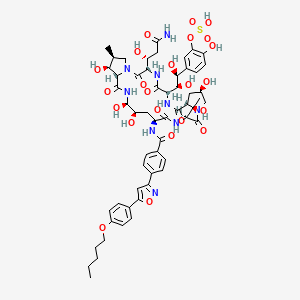Ferroptosis-centered Drug Response Information
General Information of the Drug (ID: ferrodrug0151)
| Name |
Micafungin
|
||||
|---|---|---|---|---|---|
| Synonyms |
Micafungin; 235114-32-6; Mycamine; Micafungin [INN]; UNII-R10H71BSWG; R10H71BSWG; CHEBI:600520; FK-463; Micafungin (INN); Mycamine(TM); Pneumocandin A0, 1-((4R,5R)-4,5-dihydroxy-N2-(4-(5-(4-(pentyloxy)phenyl)-3-isoxazolyl)benzoyl]-L-ornithine)-4-((4S)-4-hydroxy-4-(4-hydroxy-3-(sulfooxy)phenyl)-L-threonine)-; FK463; MICAFUNGIN [MI]; MICAFUNGIN [JAN]; MICAFUNGIN [VANDF]; MICAFUNGIN [WHO-DD]; MICAFUNGIN [EMA EPAR]; CHEMBL457547; SCHEMBL11893279; PIEUQSKUWLMALL-YABMTYFHSA-N; BDBM50478216; DB01141; D08218; EN300-19634541; J-015136; Q6827850; [5-[(1S,2S)-2-[[(1R)-3-amino-1-hydroxy-3-oxo-propyl]-tetrahydroxy-[(1R)-1-hydroxyethyl]-methyl-hexaoxo-[[4-[5-(4-pentoxyphenyl)isoxazol-3-yl]benzoyl]amino][?]yl]-1,2-dihydroxy-ethyl]-2-hydroxy-phenyl] hydrogen sulfate; 5.1:6-anhydro{(4R,5R)-4,5-dihydroxy-N(2)-(4-{5-[4-(pentyloxy)phenyl]isoxazol-3-yl}benzoyl)-L-ornithyl-L-threonyl-(4R)-4-hydroxy-L-prolyl-(4S)-4-hydroxy-4-[4-hydroxy-3-(sulfooxy)phenyl]-L-threonyl-(3R)-3-hydroxy-L-glutaminyl-(3S,4S)-3-hydroxy-4-methyl-L-proline}; PNEUMOCANDIN A0, 1-((4R,5R)-4,5-DIHYDROXY-N(SUP 2)-(4-(5-(4-(PENTYLOXY)PHENYL)-3-ISOXAZOLYL)BENZOYL)-L-ORNITHINE)-4-((4S)-4-HYDROXY-4-(4-HYDROXY-3-(SULFOOXY)PHENYL)-L-THREONINE)-
Click to Show/Hide
|
||||
| Structure |
 |
||||
|
3D MOL
|
|||||
| Formula |
C56H71N9O23S
|
||||
| IUPAC Name |
[5-[(1S,2S)-2-[(3S,6S,9S,11R,15S,18S,20R,21R,24S,25S,26S)-3-[(1R)-3-amino-1-hydroxy-3-oxopropyl]-11,20,21,25-tetrahydroxy-15-[(1R)-1-hydroxyethyl]-26-methyl-2,5,8,14,17,23-hexaoxo-18-[[4-[5-(4-pentoxyphenyl)-1,2-oxazol-3-yl]benzoyl]amino]-1,4,7,13,16,22-hexazatricyclo[22.3.0.09,13]heptacosan-6-yl]-1,2-dihydroxyethyl]-2-hydroxyphenyl] hydrogen sulfate
|
||||
| Canonical SMILES |
CCCCCOC1=CC=C(C=C1)C2=CC(=NO2)C3=CC=C(C=C3)C(=O)NC4CC(C(NC(=O)C5C(C(CN5C(=O)C(NC(=O)C(NC(=O)C6CC(CN6C(=O)C(NC4=O)C(C)O)O)C(C(C7=CC(=C(C=C7)O)OS(=O)(=O)O)O)O)C(CC(=O)N)O)C)O)O)O
|
||||
| InChI |
InChI=1S/C56H71N9O23S/c1-4-5-6-17-86-32-14-11-28(12-15-32)39-21-33(63-87-39)27-7-9-29(10-8-27)49(75)58-34-20-38(70)52(78)62-54(80)45-46(72)25(2)23-65(45)56(82)43(37(69)22-41(57)71)60-53(79)44(48(74)47(73)30-13-16-36(68)40(18-30)88-89(83,84)85)61-51(77)35-19-31(67)24-64(35)55(81)42(26(3)66)59-50(34)76/h7-16,18,21,25-26,31,34-35,37-38,42-48,52,66-70,72-74,78H,4-6,17,19-20,22-24H2,1-3H3,(H2,57,71)(H,58,75)(H,59,76)(H,60,79)(H,61,77)(H,62,80)(H,83,84,85)/t25-,26+,31+,34-,35-,37+,38+,42-,43-,44-,45-,46-,47-,48-,52+/m0/s1
|
||||
| InChIKey |
PIEUQSKUWLMALL-YABMTYFHSA-N
|
||||
| PubChem CID | |||||
Full List of Ferroptosis Target Related to This Drug
Nuclear factor erythroid 2-related factor 2 (NFE2L2)
| In total 1 item(s) under this Target | |||||
| Experiment 1 Reporting the Ferroptosis-centered Drug Act on This Target | [1] | ||||
| Target for Ferroptosis | Marker/Suppressor | ||||
| Responsed Disease | Ischemia/reperfusion injury | ICD-11: DB98 | |||
| Responsed Regulator | Mucosa-associated lymphoid tissue lymphoma translocation protein 1 (MALT1) | Driver | |||
| Pathway Response | Ferroptosis | hsa04216 | |||
| Fatty acid metabolism | hsa01212 | ||||
| Cell Process | Cell ferroptosis | ||||
| In Vitro Model | CHO-S/H9C2 cells | Normal | Cricetulus griseus | CVCL_A0TS | |
| In Vivo Model |
The surgical procedure for establishing the myocardial I/R injury rat model was carried out as we did before. Briefly, a left thoracotomy was performed in the fourth intercostal space and the heart was exposed via opening thepericardium. The left coronary artery was surrounded with a 4-0 silk suture and a snare was formed by passing both ends of the suture via a short polyethylene tubing. Blockage of the coronary artery was conducted via clamping the snare against the heart surface. Reperfusion was performed by release of the snare. The sham group conducted the same procedure but without ischemia (the snare was not tightened). To establish the I/R injury model, the rat hearts were subjected to 1 h-ischemia plus 3 h-reperfusion. At the end, the blood and hearts were collected for assay of the creatine kinase(CK) activity and infarct size to determine the success of I/R injury model. To explore the role of MALT1 in myocardial I/R injury the underlying mechanisms, three sets of experiment were performed.
Click to Show/Hide
|
||||
| Response regulation | The inhibition of MALT1 can reduce ischemia/reperfusion-induced myocardial ferroptosis through enhancing the Nrf2/SLC7A11 pathway; and MALT1 may be used as a potential target to seek novel or existing drugs (such as micafungin) for treating myocardial infarction. | ||||
Cystine/glutamate transporter (SLC7A11)
| In total 1 item(s) under this Target | |||||
| Experiment 1 Reporting the Ferroptosis-centered Drug Act on This Target | [1] | ||||
| Target for Ferroptosis | Suppressor | ||||
| Responsed Disease | Ischemia/reperfusion injury | ICD-11: DB98 | |||
| Responsed Regulator | Mucosa-associated lymphoid tissue lymphoma translocation protein 1 (MALT1) | Driver | |||
| Pathway Response | Ferroptosis | hsa04216 | |||
| Fatty acid metabolism | hsa01212 | ||||
| Cell Process | Cell ferroptosis | ||||
| In Vitro Model | CHO-S/H9C2 cells | Normal | Cricetulus griseus | CVCL_A0TS | |
| In Vivo Model |
The surgical procedure for establishing the myocardial I/R injury rat model was carried out as we did before. Briefly, a left thoracotomy was performed in the fourth intercostal space and the heart was exposed via opening thepericardium. The left coronary artery was surrounded with a 4-0 silk suture and a snare was formed by passing both ends of the suture via a short polyethylene tubing. Blockage of the coronary artery was conducted via clamping the snare against the heart surface. Reperfusion was performed by release of the snare. The sham group conducted the same procedure but without ischemia (the snare was not tightened). To establish the I/R injury model, the rat hearts were subjected to 1 h-ischemia plus 3 h-reperfusion. At the end, the blood and hearts were collected for assay of the creatine kinase(CK) activity and infarct size to determine the success of I/R injury model. To explore the role of MALT1 in myocardial I/R injury the underlying mechanisms, three sets of experiment were performed.
Click to Show/Hide
|
||||
| Response regulation | The inhibition of MALT1 can reduce ischemia/reperfusion-induced myocardial ferroptosis through enhancing the Nrf2/SLC7A11 pathway; and MALT1 may be used as a potential target to seek novel or existing drugs (such as micafungin) for treating myocardial infarction. | ||||
